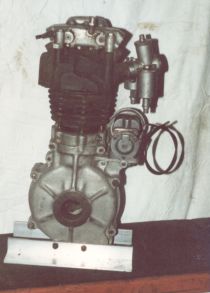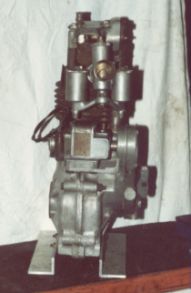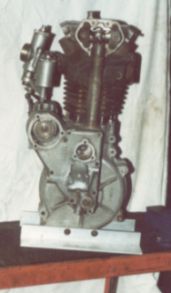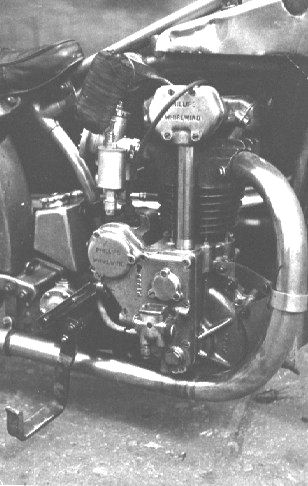






(Images of surviving engine and information courtesy Ray Spearman).
In 1934, Wal Philips designed his very own engine, the "Phillips Whirlwind". Only two of these engines were ever built at the Blackburne Factory in Bookham, Surrey and were mounted in a Rudge Frame.
Bore/Stroke: 82x94mm.
Compression Ratio: 15:1
Carb: Amal twin float track type.
Magneto: BTH Racing, gear driven.
Oil pump: Lamplough double feed.
Wal could only remember that the inlet valve was larger than the JAP at that time and that the valve angle was less then on a JAP.
Cylinder and barrel in cast iron nickel alloy called Meeanite.
Crankcase in No. 53 Rolls Royce aluminium alloy from High Duty Alloy Foundry. The flywheels were from 85 ton steel forgings with the mainshafts integral with each wheel. Roller big ends with 2 thou tapes on parallel crankpins 1/2" caged rollers.
There are six bolts evenly spaced around the cylinder which secure it to the cases.
The magneto and camshaft were gear driven. The high cam gave short pushrods. All the gears were on needle rollers and ball bearings. The timing side mainshaft was secured to a deep row ball race so there was no end float, and the drive shaft ran on a 3 row caged roller bearing. These mainbearings were in steel housings.
The rockerbox enclosed the valves and a hairpin spring in it, returned the rockers and pushrods.
Until recently, it was unclear as to wether or not either of the two engines still existed, but thanks to Mark Spearman and his father Ray, we can now show the sole surfing motor.
Ray was a very good friend of Wal's, and helped Wal on his wheel-rim braking system, and still has Wal's prototype for this system. It didn't have any calipers on it, but Wal being Wal used mole-grips instead!!
Ray gives us his account of the "Whirlwind" ..........
Wal built the engines in 1933. At the time, he was using JAP engines for speedway and a Cotton-JAP was used for racing at Brooklands for Bill Lacey. Developing the JAP engine gave him ideas of what he would like to build into an engine of his own, with speedway and Brooklands in mind.
The castings and most of the machining was carried out by Blackburne's. The engine was over-engineered and very heavy. One engine had the flywheel and mainshaft integral, the other had pressed and keyed mainshafts. All timing gears ran on ball races.The cam lobes were screwed onto a common spindle, so that you could shim them to alter the timing. It had roller cam followers. The magneto had vernier adjustment on the driving gear. Rocker shafts ran on needle rollers. The barrel is deeply spigoted into the crankcase and the lubrication for the engine was total loss. The engine was fitted into a modified Wallis frame. Wal rode the bike in Australia, but it proved too heavy.
The other engine did not blow up. As there were no spares, Wal had to cannibalise the second engine for mods and to keep one engine running. I also have the crankcases from the second engine. The rest of this second engine was dismantled.
As Wal was still developing the JAP engine, he was committed to use these in his racing machinery. Therefore, the Whirlwind got left on the bench. The Whirlwind lay in boxes in Wal's garage for many years. As Wal moved house three times, many parts of the engine went missing.
Before his last move, I suggested to Wal that we should assemble his engine. Instead, on his last move, he said I could have it and try to put it together. I discovered there was no crankshaft or piston, so the engine is now only a shell. Also, the camshaft was missing. Possibly this was lent out to someone, I will never know. There is enough of the engine to rebuild it. The covers with the name on are missing, but these could be re-cast. You can see some of the JAP engine design incorporated in it. As you say, it is a unique engine, and one day it may be back to its former glory.
On a final note, Bryan Lambert found a picture in an old VMCC magazine of Vic together with his "Whirlwind" machine which in itself is something of a rarity - Many thanks Bryan.